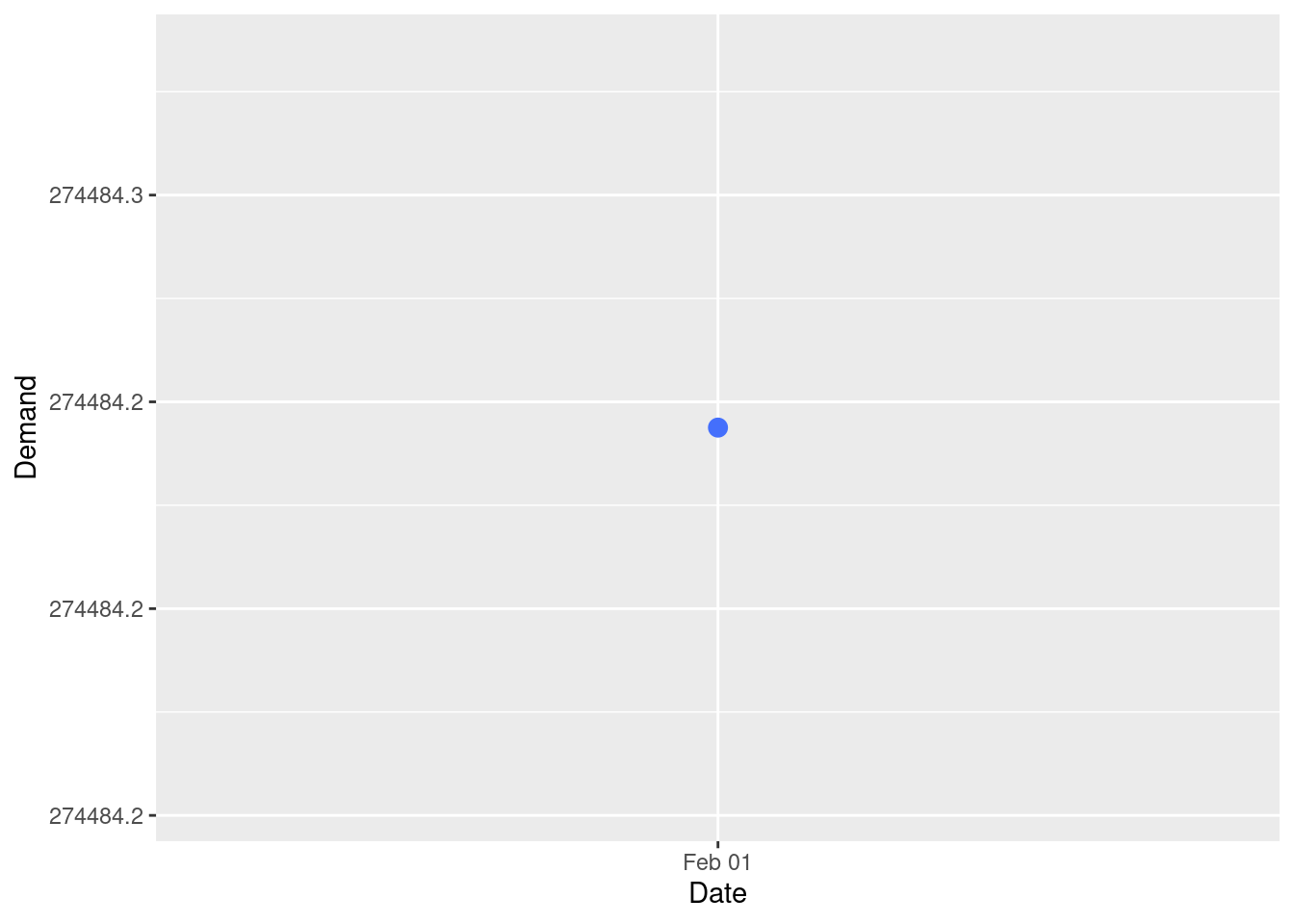Exercises
- Data is from
vic_elec Australia January 2014 electricity demand and maximum temperatures.
jan14_vic_elec <- vic_elec |>
filter(yearmonth(Time) == yearmonth("2014 Jan")) |>
tsibble::index_by(Date = as_date(Time)) |>
summarise(
Demand = sum(Demand),
Temperature = max(Temperature)
)
jan14_vic_elec%>%head
## # A tsibble: 6 x 3 [1D]
## Date Demand Temperature
## <date> <dbl> <dbl>
## 1 2014-01-01 175185. 26
## 2 2014-01-02 188351. 23
## 3 2014-01-03 189086. 22.2
## 4 2014-01-04 173798. 20.3
## 5 2014-01-05 169733. 26.1
## 6 2014-01-06 195241. 19.6
- Plot the data and find the regression model for Demand with temperature as a predictor variable. Why is there a positive relationship?
ggplot(jan14_vic_elec,aes(x=Temperature,y=Demand))+
geom_point()+
geom_smooth(method = "lm")
## `geom_smooth()` using formula = 'y ~ x'

- Produce a residual plot. Is the model adequate? Are there any outliers or influential observations?
jan14_vic_elec%>%
autoplot()+
geom_smooth()
## Plot variable not specified, automatically selected `.vars = Demand`
## `geom_smooth()` using method = 'loess' and formula = 'y ~ x'

- Use the model to forecast the electricity demand that you would expect for the next day if the maximum temperature was 15∘C and compare it with the forecast if the with maximum temperature was 35∘C. Do you believe these forecasts? The following R code will get you started:
jan14_vic_elec |>
model(TSLM(Demand ~ Temperature)) |>
forecast(
new_data(jan14_vic_elec, 1) |>
mutate(Temperature = 15)
) |>
autoplot(jan14_vic_elec)
## Warning: Computation failed in `stat_interval()`.
## Caused by error in `trans$transform()`:
## ! `transform_date()` works with objects of class <Date> only
## Warning in min(x, na.rm = na.rm): no non-missing arguments to min; returning
## Inf
## Warning in max(x, na.rm = na.rm): no non-missing arguments to max; returning
## -Inf
## Warning in min(x, na.rm = na.rm): no non-missing arguments to min; returning
## Inf
## Warning in max(x, na.rm = na.rm): no non-missing arguments to max; returning
## -Inf
## Warning in min(x, na.rm = na.rm): no non-missing arguments to min; returning
## Inf
## Warning in max(x, na.rm = na.rm): no non-missing arguments to max; returning
## -Inf

fcst_vic_elec_jan14_15 <- jan14_vic_elec %>%
model(tslm = TSLM(Demand ~ Temperature)) %>%
forecast(
new_data(jan14_vic_elec, 1) %>%
mutate(Temperature = 15)
)
fcst_vic_elec_jan14_15 %>%
autoplot()
## Warning: Computation failed in `stat_interval()`.
## Caused by error in `trans$transform()`:
## ! `transform_date()` works with objects of class <Date> only
## Warning in min(x, na.rm = na.rm): no non-missing arguments to min; returning
## Inf
## Warning in max(x, na.rm = na.rm): no non-missing arguments to max; returning
## -Inf
## Warning in min(x, na.rm = na.rm): no non-missing arguments to min; returning
## Inf
## Warning in max(x, na.rm = na.rm): no non-missing arguments to max; returning
## -Inf
## Warning in min(x, na.rm = na.rm): no non-missing arguments to min; returning
## Inf
## Warning in max(x, na.rm = na.rm): no non-missing arguments to max; returning
## -Inf

fcst_vic_elec_jan14_15$Demand[1]
## <distribution[1]>
## 1
## N(151398, 6.8e+08)
# Source: https://robjhyndman.com/hyndsight/fable/
# 80% prediction intervals
hilo(fcst_vic_elec_jan14_15, level = 80)
## # A tsibble: 1 x 6 [1D]
## # Key: .model [1]
## .model Date Demand .mean Temperature `80%`
## <chr> <date> <dist> <dbl> <dbl> <hilo>
## 1 tslm 2014-02-01 N(151398, 6.8e+08) 1.51e5 15 [117908.1, 184888.6]80
# 95% prediction intervals
hilo(fcst_vic_elec_jan14_15, level = 95)
## # A tsibble: 1 x 6 [1D]
## # Key: .model [1]
## .model Date Demand .mean Temperature `95%`
## <chr> <date> <dist> <dbl> <dbl> <hilo>
## 1 tslm 2014-02-01 N(151398, 6.8e+08) 1.51e5 15 [100179.4, 202617.3]95
# forecast next day with maximum temperature = 35 degrees Celsius
jan14_vic_elec %>%
model(tslm = TSLM(Demand ~ Temperature)) %>%
forecast(
new_data(jan14_vic_elec, 1) %>%
mutate(Temperature = 35)
) %>%
autoplot()
## Warning: Computation failed in `stat_interval()`.
## Caused by error in `trans$transform()`:
## ! `transform_date()` works with objects of class <Date> only
## Warning in min(x, na.rm = na.rm): no non-missing arguments to min; returning
## Inf
## Warning in max(x, na.rm = na.rm): no non-missing arguments to max; returning
## -Inf
## Warning in min(x, na.rm = na.rm): no non-missing arguments to min; returning
## Inf
## Warning in max(x, na.rm = na.rm): no non-missing arguments to max; returning
## -Inf
## Warning in min(x, na.rm = na.rm): no non-missing arguments to min; returning
## Inf
## Warning in max(x, na.rm = na.rm): no non-missing arguments to max; returning
## -Inf

- Give prediction intervals for your forecasts.
vic_elec %>%
filter(yearmonth(Time) == yearmonth("2014 Feb")) %>%
index_by(Date = as_date(Time)) %>%
summarise(
Demand = sum(Demand),
Temperature = max(Temperature) # select maximum temperature
) %>%
slice(1)
## # A tsibble: 1 x 3 [1D]
## Date Demand Temperature
## <date> <dbl> <dbl>
## 1 2014-02-01 241283. 29.2
# forecast demand for maximum temperature = 15 degrees Celsius --> 151,398 (mean)
# forecast demand for maximum temperature = 35 degrees Celsius --> 274,484 (mean)
# actual demand for Feb 1, 2014 --> 241,283 with maximum temperature of 29.2 degrees Celsius
- Plot Demand vs Temperature for all of the available data in vic_elec aggregated to daily total demand and maximum temperature. What does this say about your model?
vic_elec %>%
select(Date, Demand, Temperature) %>%
index_by(Date) %>%
summarise(
Demand = sum(Demand),
Temperature = max(Temperature) # select maximum temperature
) %>%
mutate(
Demand = scale(Demand),
Temperature = scale(Temperature)
) %>%
pivot_longer(c(Demand, Temperature), names_to = 'Series') %>%
autoplot(value) +
labs(x = NULL,
y = 'Value',
title = 'Victoria 2014 Electricity Daily Demand vs. Maximum Temperature (scaled)')

fit_trends <- jan14_vic_elec |>
model(
linear = TSLM(Demand ~ trend()),
exponential = TSLM(log(Demand) ~ trend()),
piecewise = TSLM(Demand ~ trend(knots = c(1950, 1980)))
)
fc_trends <- fit_trends |> forecast(h = 10)
## Warning: There was 1 warning in `mutate()`.
## ℹ In argument: `piecewise = (function (object, ...) ...`.
## Caused by warning:
## ! prediction from a rank-deficient fit may be misleading





